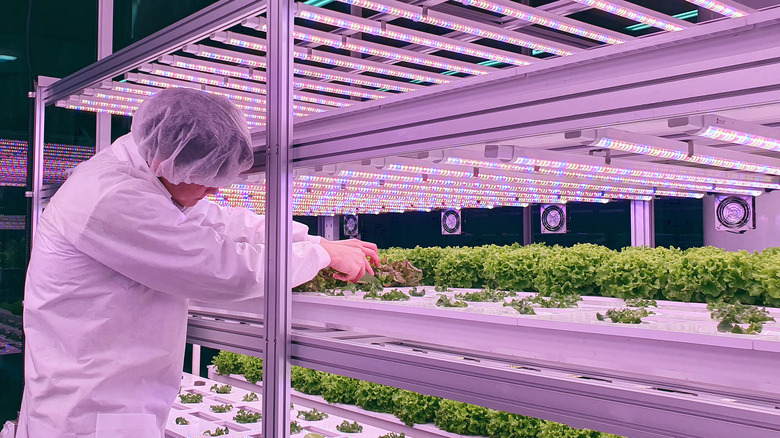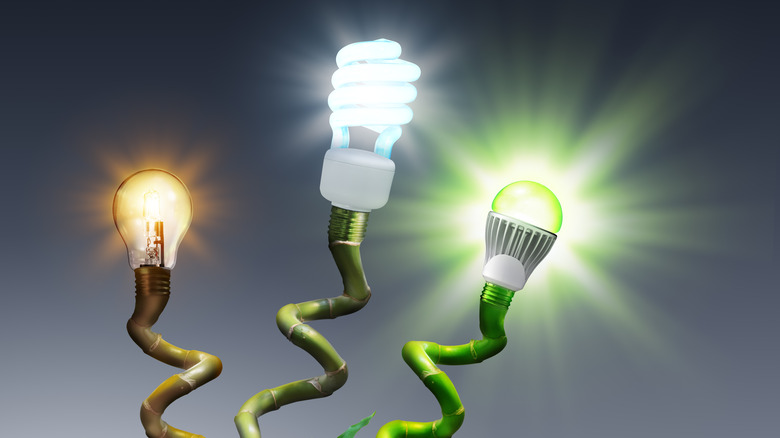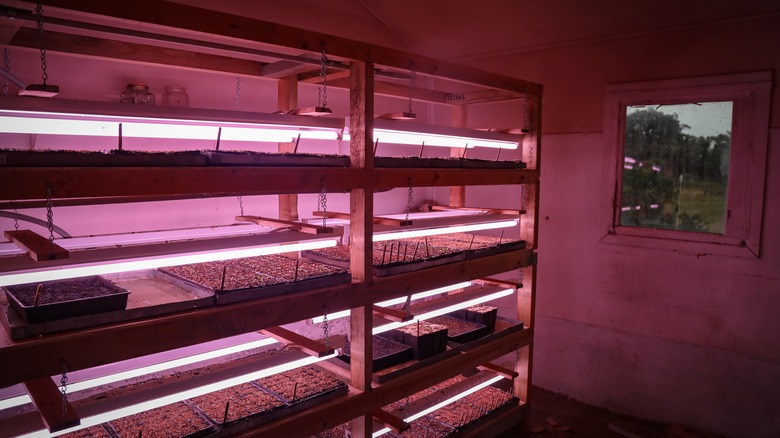How To Choose The Perfect Grow Light To Help Your Plants Thrive
There was a time, more recent than the last recession and the launch of Minecraft, when using the term "grow light" made some people wonder if you were a cannabis grower. Now, though, almost everyone assumes it's true. But the truth is that other plants are occasionally grown indoors by home gardeners, and those plants are going to need some light.
There are two main situations that require grow lights: Starting seeds and growing plants to maturity, through the fruiting or flowering stages, according to Upstart University. These are among the dozens, maybe hundreds, of factors to consider when choosing a grow light setup. And some people ignore almost all of them, with great success. The secret to finding the "perfect" grow light is to find one that's perfect for you, and not necessarily optimal in terms of dollars of revenue per square centimeter of growing medium.
Still, the only way to figure out if you care is to think through all the ins and outs: Are you starting seeds and growing seedlings under light, or will your plants produce flowers and/or vegetables there as well? What fits your budget and your space? What color temperature is best for you? Are the lights going to be too hot? How will you adjust the height of the lights as plants grow? Is coverage going to be similar enough for all the plants under a particular light? Do they really have airplanes that can detect these things?
Grow lights for seedlings
Seedlings have special requirements and require a bit more attention than you'd think, given that they don't really need light or much in the way of soil for the first week or so. But just as nutrient-rich soil can harm or kill a newly sprouted plant, according to Bios Grow Lighting, some cuttings and seedlings at first require far less light power than mature plants, but will later require more than their outdoors counterparts. And they require different types of light, as well.
So, how much light do seedlings need? In addition to probably being a science fiction weapons technology, photosynthetic photon flux density (PPFD) is a unit of light intensity by which you can compare grow lights. In addition to probably being a colonial-era technology for burning your toes, the foot-candle is a measure of visible light intensity employed by those in backwards countries that use imperial measurements and can't be trusted with terms like "photon." ("Lux" is the same information measured per square meter, rather than per square foot.) The difference between PPF and foot-candles is that the latter takes into account only light humans can see, while PPF measures light used by photosynthesis regardless of whether we can see it with the naked eye (via Photone). PPF is the one you care about when it comes to grow lights. For seedlings, your plants might require 100–300 µMol/m2/S, whereas the range might be 200-600 µMol/m2/S (less for lettuces and herbs) and for the 500-750 µMol/m2/S for the vegetative and flowering stages, respectively (via Mars Hydro).
There are situations where seedlings require more light intensity than you'd expect. Seedlings that will spend a lot of time indoors and areas with little natural light will have higher PPFD requirements.
In general, for seedlings, look for lights that fall in the blue-green part of the spectrum, or for a balanced light that covers the full spectrum well (via the University of Minnesota Extension service).
Grow lights for fruiting or flowering plants
More mature plants in the vegetative, flowering, or fruit-producing stages will require more light energy than seedlings, and far more than new seed starts will in the seed leaf stage. They also require different wavelengths in the light spectrum.
Mars Hydro uses cucumbers/tomatoes, peppers/other flowering plants, and lettuces/herbs as the categories to illustrate PPFD needs. For cucumbers and tomatoes, the light intensity required jumps from 100-200 µMol/m2/S to 200-500 and 500-600 µMol/m2/S for the vegetative and flowering stages. Peppers and the like graduate from 100-300 to 300-600 µMol/m2/S, then to 600-750 µMol/m2/S when flowering.
Lettuces and herbs have dramatically lower requirements and their flowering stage is not relevant, so you see a jump from 100 µMol/m2/S for seedlings to only 100-250 during vegetative stages.
Leafy greens are closer to seedlings in light requirements, too, benefiting from blue or mixed-light bulbs, while red or mixed light is better for bud formation in flowering plants, and for keeping plants shorter. White or a mixed and balanced light can be used for any stage of growth (via the University of Minnesota Extension).
Types of grow light fixtures
Grow lights come in a number of form factors for different situations and different plants' requirements. You can spend as little or as much time and money on lighting as you want and be successful in any of those situations, with a few basic principles held firmly in mind. Grow light bulbs come in a huge variety of shapes and sizes, from ordinary bulbs to PAR38 floodlights to long tubes (think fluorescent tubes, but sometimes with strips of LEDs inside). They can be integrated into fixtures, such as the full-spectrum BoostGro lights sold by Lowe's, or fixtures can be purchased separately from the bulbs.
Fixtures themselves are designed with a number of goals held in balance, varying among types of grower needs. They can range from ordinary fluorescent shop lights to elaborate commercial fixtures to enormous and enormously expensive bespoke systems for commercial growers. The more involved panels, bars, and panels of bars are designed for optimizing crops, and are overkill for most home growers. What's important is that the bulbs/lamps and their fixtures work together to address a particular set of concerns: intensity, spectrum, distribution, temperature, and control. These will affect the way you buy or build and use your grow lights (via Grow Journey).
The other things you should be thinking about are location and fixture size. The location will determine a lot of your needs because it defines how much (if any) natural light your plants will be getting. The more natural light, the less supplemental light is needed. And size is obviously, in part, a function of your available space and whatever shelves/tables you plan to use.
The final piece of the puzzle is adjustability, which relates to several other factors. Uniformity of light distribution and proper temperature are often achieved by the home grower using fixtures that can be adjusted, at least vertically.
Spectrum: What is color temperature, and did a toddler make it up?
When one first encounters the term "color temperature," it's natural to assume the phrase was coined by a child, a madman, or a synesthete who shivers uncontrollably during a glowy blue midsummer sunset. But color temperature isn't madness at all... or, at least, not entirely. Color temperature describes where a particular light falls in an amber-to-blue spectrum, says LEDsave. Color temperature is measured in kelvin (K), and bulbs typically range from 2700K to 6500K. You'll see them described using terms like "warm white" or "daylight," but these are subjective terms that can cloud the issue. For reference, warm white light is typically around 3000K, while "daylight" tends to fall around 6000K.
What's important for plant-growing purposes is to imitate sunlight. But while your kitchen might look best in a narrow band of lights around 3200K, plants can react to a broad range of light from ultraviolet to far-red radiation, much of which is not visible to the human eye. The business end of this light, though, isn't the end at all, but a part in the middle called Photosynthetically Active Radiation (PAR). As you might have guessed, this is the light used by plants for photosynthesis and, therefore, just about everything plants do. The most active part of PAR falls within a range of about 400 nanometers (nm) to around 700 nm. We've said that the blue area of this spectrum is good for seedlings and early vegetative growth, while the red and is good for vegetative growth and flowering/fruiting. But there are other considerations: UV light can burn plants and people, but is also beneficial to plants' color, taste, and aroma. Far-red light, on the other hand, can trigger legginess in plants because it's perceived as a component of shade (via the Michigan State University extension service), but it also has an effect in support of flowering and, in some cases, fruit yield (via Bios Grow Lighting).
Light distribution: horticultural communism
If your goal is to grow a bunch of plants fairly evenly (and why would you want to grow a bunch of plants unevenly?), then light distribution is the arcane horticulture topic for you. But good distribution even matters to a single plant. The classic clue to uneven light distribution is a plant that reorients itself for maximum exposure to a particular light source, according to Bios Grow Lighting. In an ideal situation, light could cover plants from every angle and would come from an infinite (or practically infinite) distance away because that means that plants would get the same amount of sunlight at any height (and therefore do not benefit from over-stretching towards light). This ideal situation exists, and is free: sunlight.
Imitating the distribution of light plants get from the sun is difficult and can be expensive. The goal is to ensure that all plants are lighted equally, and that each plant's surface area is exposed to as much light as all the others (via Maximum Yield). The size, shape and orientation of light fixtures can help with even distribution, as can applying reflectors or reflecting foil. Moving lights have a clear (and clearly pricey) advantage over stationary lights (via Light Rail).
Light distribution is difficult to accurately measure, and for the home grower shooting for maximum distribution might be another case of overkill. What's important is to think about distribution as you make lighting decisions for your growing space.
Temperature: the easy part
It's not likely you will find yourself in a climate-controlled indoor-growing situation where your plants are too cold, but it's all too easy to overheat them with your grow lighting. The ideal temperature varies by species, of course, but on average your plants will do well in 78-80 degrees Fahrenheit during the day, and 65-70 degrees at night, says the University of Georgia extension service. This is not difficult to achieve in most indoor spaces; during the early and late parts of the season, you might need some supplemental heating or thermal mass to release heat during colder stretches.
Lights, on the other hand, can cause significant problems for maintaining plant temperature at appropriate levels. Most grow lights today are efficient in comparison with earlier generations of lights, which means they produce less heat (which is electricity inefficiently converted to heat instead of light). But the sheer size, number, and intensity of modern grow lights mean you can still develop a heat problem. Sometimes this is caused by factors like mismatching the lamp and fixture or inadequate airflow (via Spider Farmer). Often, especially for the home grower, it's simply a matter of having the grow lights too close to the plants. Monitor your plants' temperature at canopy height and adjust as necessary.
Lighting control: How much light is enough, anyway?
So now you know what light looks like and where you can find it, but how much should you be using? Though guessing and experience are perfectly workable traditional ways to light plants, you can get downright scientific about it. Either way, pay attention to your light schedules, because the consequences of too little or too much light can be severe.
The University of Vermont extension service recommends 16-18 hours per day of lighting for seedlings. More mature plants generally need less light, usually around 12-14 hours a day. This depends on the plant being grown, of course, and on the quality of the grow light being used. When you calculate the plant's lighting requirements against the specifications of your grow light, you might find that you'd need to run the light more than 24 hours per day to get all the light you need... in which case you might need to consider a different lighting strategy (via the University of New Hampshire extension service).
How you achieve such a schedule depends on your lighting, budget, and patience. You can always do it manually, though this is unreliable. More realistic options include simple electrical timers, dedicated horticultural timers and control systems, and a wide variety of smart home equipment that can be pressed into service for the purpose.
Lamp types
Grow lights are, at their core, just particular types of light bulbs. As bewildering as the light bulb selection is at your local big box home improvement store, the variety available as grow lights is somehow both smaller and even more bewildering. We'll simplify things by eliminating a couple of choices up front.
The first is incandescent lighting. These traditional bulbs are being phased out in general because of their inefficiency, and should be phased out of your grow light rig as well. Their inefficiency causes them to run very hot, according to the University of Minnesota extension service, on top of which they tend to need frequent replacement and can cause plants to become leggy. They are the cheapest option, but when a low price is something's only advantage, you know you're asking for trouble.
High-intensity discharge (HID) lights are another option we'll dispense with up front. You might be familiar with HID lights if you've recently shopped for automobile headlights. HID grow lights, which include metal halide and high-pressure sodium lights, put out a lot of light and cover a very large area. As such, they typically require grow rooms of substantial height, and they run quite hot. While they are a great choice for certain commercial operations, their intensity can lead to lack of uniformity in growth (via Bios Grow Lighting), and the levels of heat are obviously a problem for home growers.
Fluorescent grow lights
Fluorescent grow lights have been the standard go-to for home and commercial use for quite a while, though they are rapidly being replaced by LEDs. Fluorescent lights are typically classified by color temperature (ideally 5,600-6,400 K), wattage, and "T" ratings that specify the width of a light tube in eighths of an inch, according to Upstart University. T5 (⅝" tubes) lights, for example, are a common choice for seedlings.
Fluorescents are fairly efficient and are often affordably priced. You can find balanced-output fluorescent bulbs, and some even recommend using long (and cheap) fluorescent tubes in warm/cool pairs for seedlings (via Garden Design). They are available in HO (high output) versions, though those tend to give off a lot of heat.
Other downsides are worth considering. Fluorescent bulbs are famously fragile, they put out less light than LEDs, and they are neither as durable nor as efficient as LEDs, toward which the home grow light market has clearly been turning for some time.
LED grow lights
LEDs might be superficially more expensive than fluorescents, but make up for that with superior energy efficiency, durability, and by emitting more light, says Upstart University. Like fluorescent lights, they also have a great deal of flexibility in terms of form factor. LEDs are easier to use when seeking a particular color temperature target, and when a lighting system is properly designed, LEDs offer even light coverage in the right configurations (via Bios Grow Lighting). And they typically have five times the lifespan of fluorescents and lower energy costs (via Hydrotek Hydroponics), so they separate themselves from the rest of the pack fairly easily.
LEDs do get hot, though not as hot as other technologies. LED light bars offer a lot of flexibility of arrangement, which makes it easy to aim for great distribution, but usually only include passive cooling (typically using aluminum heat sinks). Active cooling, usually fan- or water-cooling, is available for many LED form factors. In the end, LEDs offer a lower total cost of ownership than the alternatives.
Ultimately, LEDs are the best choice in most circumstances. And, again, you don't have to spend a fortune for home growing. Just as with the fluorescent users who pair cool and warm bulbs to get a fuller spectrum more cheaply, there are a wide range of options that work to some degree, including sticking a tray of plants near a window and hoping for the best. Find the point you're happy with, and go for it.










